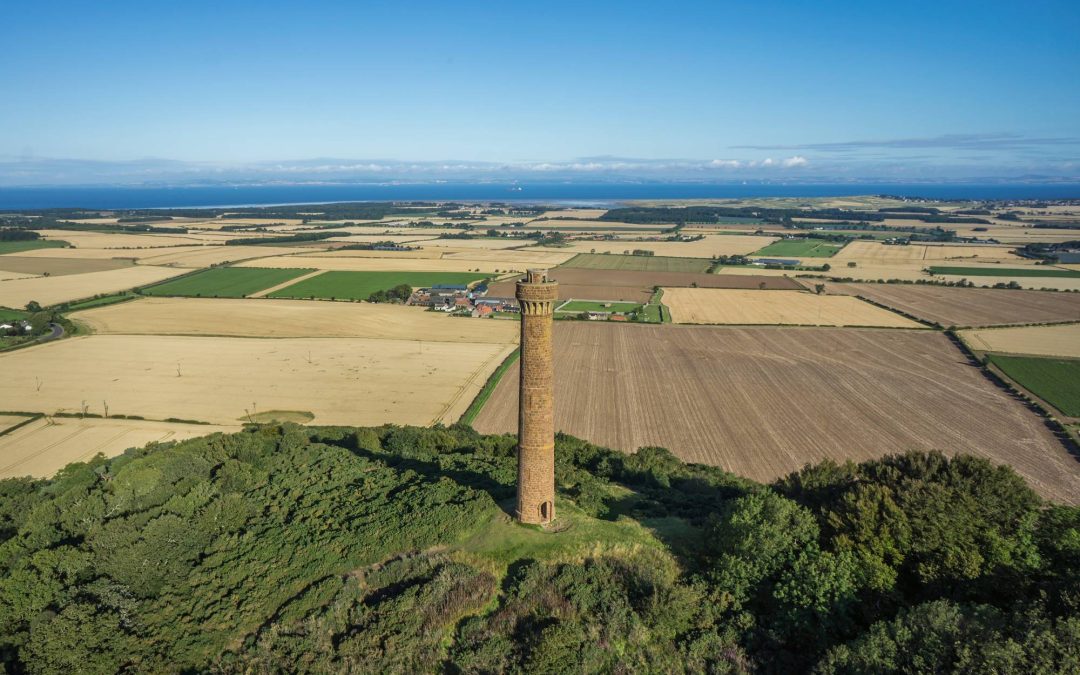Hopetoun Monument in East Lothian, Scotland, is a prominent landmark that has stood tall for over two centuries. The monument was built in 1824 in memory of Sir John Hope, who was a renowned soldier and politician. It is located on Byres Hill, which is part of the Hopetoun Estate and offers breathtaking views of the surrounding countryside.
The Hopetoun Monument is an impressive structure that stands at 95 feet tall and is made of local sandstone. It was designed by William Burn, a famous Scottish architect, and features a spiral staircase that leads to a viewing platform at the top. From here, visitors can enjoy panoramic views of the Firth of Forth, the Pentland Hills, and the surrounding countryside.
The monument is a popular destination for hikers and history enthusiasts alike. It is easily accessible by foot and offers an excellent opportunity to explore the beautiful East Lothian countryside. Whether you’re interested in history, architecture, or simply want to enjoy the stunning views, the Hopetoun Monument is definitely worth a visit.
History of Hopetoun Monument
The Hopetoun Monument is a prominent landmark located in East Lothian, Scotland. It was erected in 1824 in memory of John Hope, the fourth Earl of Hopetoun, who was an esteemed politician and diplomat.
The monument was designed by William Burn, a renowned Scottish architect, and stands at an impressive 95 feet tall. It is made of sandstone and features a square base with four pillars, topped by an octagonal tower with a viewing platform at the top.
The monument was built to commemorate the life and achievements of John Hope, who was a respected figure in Scottish society. He served as Lord Lieutenant of Linlithgowshire and was also a Member of Parliament for Edinburgh.
The monument was funded by public subscription, with many local residents and admirers of John Hope contributing to its construction. It was unveiled on 17th September 1824, with a ceremony attended by many dignitaries and members of the public.
Today, the Hopetoun Monument remains a popular tourist attraction and a symbol of the rich history and heritage of East Lothian. Visitors can climb to the top of the tower to enjoy panoramic views of the surrounding countryside, and learn more about the life and legacy of John Hope.
Location and Surroundings
Hopetoun Monument is located in East Lothian, Scotland, near the town of Haddington. The monument stands on top of Byres Hill, which is part of the Garleton Hills range. The Garleton Hills are a prominent feature of East Lothian’s landscape and provide stunning views of the surrounding area.
From the top of Byres Hill, visitors can see the Firth of Forth and the city of Edinburgh to the west, as well as the hills of Fife to the north. On a clear day, it is even possible to see as far as the Cairngorms and the Borders.
The monument is situated on Garleton Farm, which is owned by the Hopetoun Estate. The farm is located in the small village of Camptoun, just a few miles from Haddington. The area surrounding the monument is rural and peaceful, with rolling hills and farmland stretching as far as the eye can see.
Access to the monument is via a footpath that starts at Skid Hill, just off the A1. The footpath is well signposted and takes visitors through fields and woods before reaching the monument. The walk is relatively easy and takes around 30 minutes each way.
Physical Description of the Monument
The Hopetoun Monument is a prominent tower located on Byres Hill in East Lothian, Scotland. The tower is made of sandstone, and it stands at a height of 95 feet. It is a category B listed building, which means it is considered to be of regional importance.
The tower was built in 1824 to commemorate Sir John Hope, who was a soldier and politician. The monument is situated on the highest point of Byres Hill, which provides excellent views of the surrounding landscape. The tower has a viewing platform at the top, which is accessible via a spiral staircase.
The tower has a square base, which measures 21 feet on each side. The tower then tapers towards the top, with the upper section being octagonal in shape. The tower has a door on the ground floor, which is made of wood and has an inscription above it.
The inscription reads: “Erected in 1824 by public subscription in memory of the late Sir John Hope, Baronet, K.C.B., Colonel of the 92nd Highlanders, who fell at the head of his brigade, storming the heights of St. Jean d’Acre, 27th May 1799, aged 45 years.”
View from the Top
Ascending to the top of Hopetoun Monument is an experience not to be missed. The views from the top are simply breathtaking. On a clear day, you can see for miles around, taking in Edinburgh, the Firth of Forth, Fife, and the Bass Rock.
Looking north, you can see the Lammermuir Hills, and on an exceptionally clear day, you might even catch a glimpse of the Cairngorms. To the south, you can see the Borders, and to the east, Tantallon Castle and Berwick Law are visible.
The gardens surrounding the monument are also worth taking a moment to appreciate. The carefully tended lawns and flower beds provide a beautiful foreground to the stunning views beyond.
It’s worth noting that the climb to the top of the monument is not for the faint of heart. The spiral staircase is narrow, and there are over 150 steps to reach the top. However, the effort is well worth it for the incredible views that await you.
Access and Facilities
The Hopetoun Monument is located in a rural area of East Lothian and can be accessed by car or on foot. There is a car park available at the base of the monument, which can accommodate up to 20 cars. The car park is free to use and is open from dawn until dusk. However, visitors are advised to park responsibly and not to obstruct any access points.
For those who prefer to walk, there is a path that leads up to the monument from the car park. The path is well-maintained and is suitable for all levels of fitness. It takes around 15-20 minutes to walk to the top of the hill, where the monument is located. The path offers stunning views of the surrounding countryside, making the walk a pleasant experience.
There are no facilities available at the monument itself. However, there is a bar located nearby, which is open daily from 11am until late. The bar serves a range of food and drinks, including local beers and spirits. Visitors can enjoy a meal or a drink before or after visiting the monument.
Flora and Fauna
Hopetoun Monument sits atop a hill with wooded slopes, providing a diverse habitat for various flora and fauna. The area is home to a range of plant species, including gorse, which blooms with bright yellow flowers in the spring and summer. The hilltop also offers a panoramic view of the surrounding area, making it a popular spot for birdwatching.
Visitors to the monument may spot jackdaws, a type of crow that is common in the area. These birds are known for their distinctive grey heads and necks and can often be seen perched on the monument itself or flying overhead.
In addition to birds, the wooded slopes around the monument are home to a variety of small mammals, such as voles and shrews. These creatures are an essential part of the local ecosystem and help to maintain the balance of the area’s biodiversity.
Preservation and Protection
Preservation and protection of the Hopetoun Monument is a top priority for the locals and the authorities responsible for the management of the historic site. The monument is located in a beautiful countryside that is designated as a protected area by the Historic Environment Scotland.
The Hopetoun Monument is a unique structure that has stood the test of time, and it is important to ensure that it remains in good condition for future generations to appreciate. To achieve this, the authorities have put in place various measures to protect and preserve the monument.
One of the key measures is regular maintenance, which involves cleaning, repairing, and replacing any damaged parts of the monument. The authorities have also restricted access to the monument to prevent any damage or vandalism. Visitors are only allowed to view the monument from a distance, and there are signs to remind them of the importance of preserving the site.
The design of the monument also plays a significant role in its preservation and protection. The monument was designed to withstand the harsh weather conditions of the area, and its sturdy construction has helped to keep it standing for centuries. The authorities have also installed protective barriers around the monument to prevent any accidental damage.
Visitor Experience
Visiting Hopetoun Monument in East Lothian is a unique experience that offers stunning views of the surrounding area. The monument is located on top of Mount Hill, which requires a moderate hike to reach the top. Visitors should be prepared for a steep climb, but the effort is well worth it.
Once at the top, visitors can take in the breathtaking views of the Firth of Forth and the surrounding countryside. The monument itself is an impressive sight, standing at 95 feet tall and built in the early 1820s to commemorate the life of Admiral John Hope.
Visitors can take photos of the monument and the surrounding views, making it a great spot for photography enthusiasts. The site also offers picnic areas for visitors who want to take a break and enjoy the scenery.
The monument is open to visitors year-round, but it is recommended to check the weather conditions before making the climb. Visitors can rate and review their experience on various travel websites, providing valuable feedback for future visitors.
Trivia and Interesting Facts
Hopetoun Monument is a fascinating piece of architecture with a rich history. Here are some interesting facts and trivia about the monument that you may not have known:
- The monument was built in 1824 in memory of Sir John Hope, a politician and army officer who fought in the Napoleonic Wars. He was later made the 4th Earl of Hopetoun.
- The monument was designed by William Burn, a renowned Scottish architect who also designed Dirleton Castle.
- The monument is 95 feet tall and stands on top of a conical hill, offering stunning views of the surrounding area. On a clear day, you can see as far as the Firth of Forth and the Edinburgh skyline.
- The monument is sometimes referred to as the “Garleton Monument” or the “Galla Monument” by locals, due to its location on Garleton Hill and its association with the Galla family, who owned the land in the 18th century.
- The monument is a hidden gem that is often overlooked by tourists. However, it is well worth a visit for its stunning views and historical significance.
- The monument features a torch at the top, which was originally lit on special occasions. The torch was recently restored and is now permanently lit.
- The monument is surrounded by a circular wall, which was added in the 19th century to prevent visitors from falling off the hill.
- The monument is a popular spot for hikers and walkers, who can enjoy a scenic climb up the hill to reach the top.
- The monument is located near Dirleton Castle, another historical site that is worth a visit for its rich history and stunning architecture.

